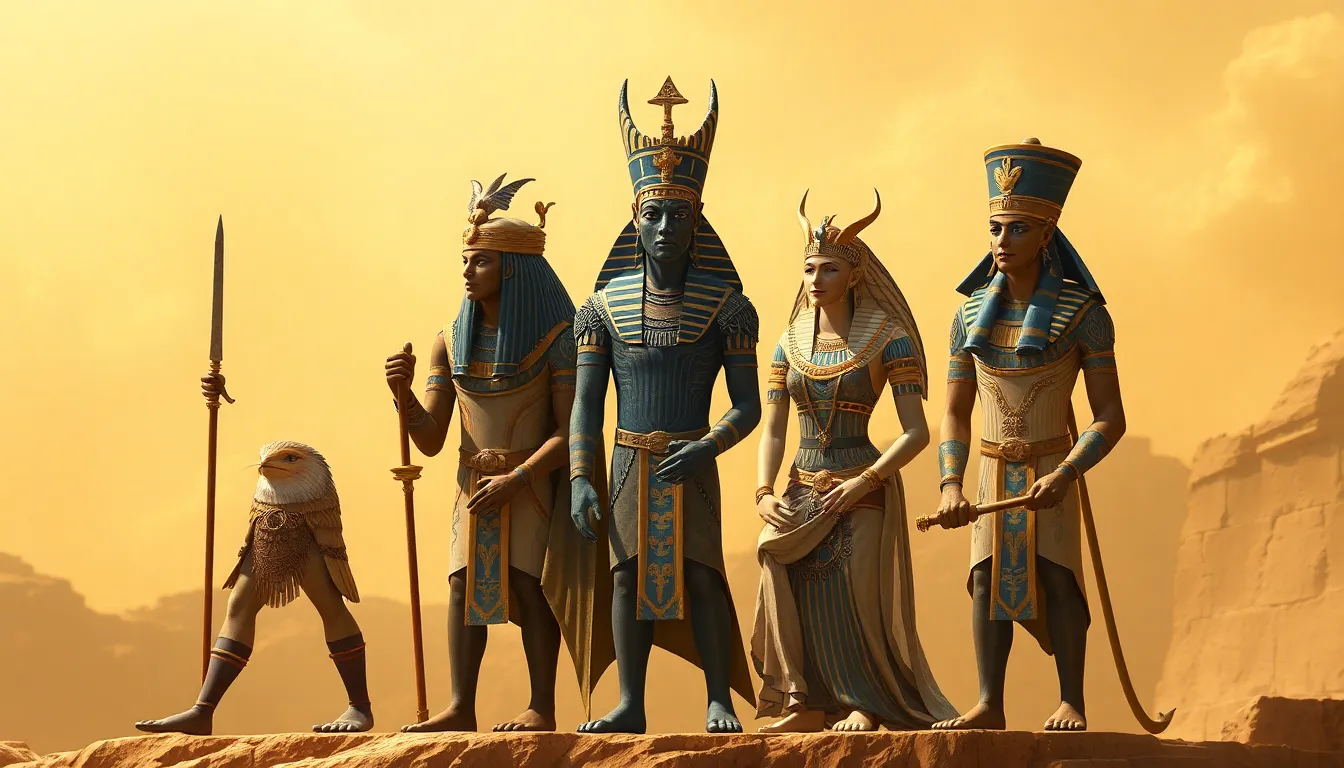The Divine Family: Relationships Between Egyptian Gods
I. Introduction to Egyptian Mythology
Ancient Egyptian mythology is rich with a diverse pantheon of gods and goddesses who played a pivotal role in the daily lives and spiritual beliefs of the Egyptian people. The gods were seen not only as powerful entities commanding nature and the cosmos but also as familial figures whose relationships mirrored those of humans. These divine relationships were crucial in understanding the interconnectedness of the gods, their roles, and their influence on the world.
The importance of familial relationships among deities cannot be overstated. They shaped the narratives that defined Egyptian religion, rituals, and societal norms. Each god and goddess had a specific role within the family structure, contributing to the mythology’s complexity and richness.
II. The Supreme Deities: Atum and Ra
Atum is often regarded as the creator god in ancient Egyptian mythology, embodying the essence of all that exists. He is believed to have emerged from the chaotic waters of Nun, bringing forth life and the universe. Atum represents the initial spark of creation, and his familial ties are foundational to the pantheon.
Ra, the sun god, is another supreme deity who holds a vital position in Egyptian belief systems. He is often identified with Atum, representing the sun at its zenith. Together, Atum and Ra symbolize the cycle of creation, life, and renewal, as Ra traverses the sky each day, bringing light and warmth to the earth.
III. The Ennead: The Nine Great Gods
The Ennead of Heliopolis is a central group of nine deities in Egyptian mythology, forming a complex family structure that illustrates the relationships between the gods. The members of the Ennead include:
- Atum
- Shu – god of air
- Tefnut – goddess of moisture
- Geb – god of the earth
- Nut – goddess of the sky
- Osiris – god of the afterlife
- Isis – goddess of magic and motherhood
- Seth – god of chaos
- Nephthys – goddess of the night and mourning
Each member of the Ennead has distinct roles and relationships, often depicted as siblings, spouses, or offspring. For instance, Shu and Tefnut are the children of Atum, while Geb and Nut are their offspring, creating a generational link among the deities that emphasizes their interconnectedness.
IV. Osiris and Isis: The Tragic Couple
Osiris is one of the most significant deities in Egyptian mythology, revered as the god of the afterlife and resurrection. His story is central to the beliefs surrounding death and the afterlife in ancient Egypt.
Isis, Osiris’s wife, plays a crucial role in his narrative as the goddess of magic and motherhood. Her devotion to Osiris is legendary; she is depicted as the ultimate caregiver and a powerful protector. Together, they represent the cycle of life, death, and rebirth, with their relationship showcasing themes of love, loyalty, and tragedy.
The impact of Osiris and Isis’s relationship extends beyond their mythos, influencing Egyptian funeral practices and beliefs about the afterlife. Their union symbolizes hope and the promise of renewal, resonating deeply within the culture.
V. Seth and His Complicated Role
Seth is known as the god of chaos, storms, and the desert, often characterized as a figure of disruption and conflict. His rivalry with Osiris is one of the most compelling tales in Egyptian mythology, as he embodies chaos that threatens the order established by the other gods.
Despite his antagonistic role, Seth has complex relationships with other deities, including Isis and Horus. His rivalry with Horus, the son of Osiris and Isis, represents the eternal struggle between order and chaos. This conflict is not merely a battle for power; it symbolizes the larger themes of good versus evil within the cosmic order.
VI. Horus: The Avenger and Protector
Horus, the son of Osiris and Isis, is often depicted as a falcon-headed god and is celebrated as the avenger of his father’s death. His journey to reclaim the throne from Seth is filled with trials and tribulations, reflecting the themes of justice, revenge, and rightful kingship.
Horus’s conflict with Seth is not just a personal vendetta; it symbolizes the struggle for balance and order in the universe. His victory over Seth is seen as a triumph of good over evil, and Horus becomes a symbol of protection and kingship in ancient Egyptian culture.
VII. The Role of Goddesses in the Divine Family
In addition to Isis, several other powerful goddesses play significant roles in the divine family. Key goddesses include:
- Hathor: Goddess of love, beauty, and motherhood, often associated with joy and music.
- Sekhmet: The lioness goddess representing war and healing, embodying duality in her protective and destructive aspects.
- Ma’at: Goddess of truth, justice, and cosmic order, essential in maintaining balance in the universe.
These goddesses influence the family dynamics of the gods and their respective roles within mythology. Each goddess contributes to the narratives that define the relationships among the deities, highlighting the importance of femininity in the divine order.
VIII. Conclusion: The Legacy of the Divine Family
The relationships between Egyptian gods create a vibrant tapestry of narratives that define ancient Egyptian mythology. The divine family structure illustrates themes of creation, conflict, love, and resurrection, deeply influencing the culture’s religious practices and beliefs.
The legacy of these relationships extends far beyond ancient times, leaving a lasting impact on art, literature, and modern interpretations of mythology. Understanding the dynamics of the divine family provides valuable insights into the values and beliefs of ancient Egyptian society, showcasing the enduring power of myth in shaping human experience.




